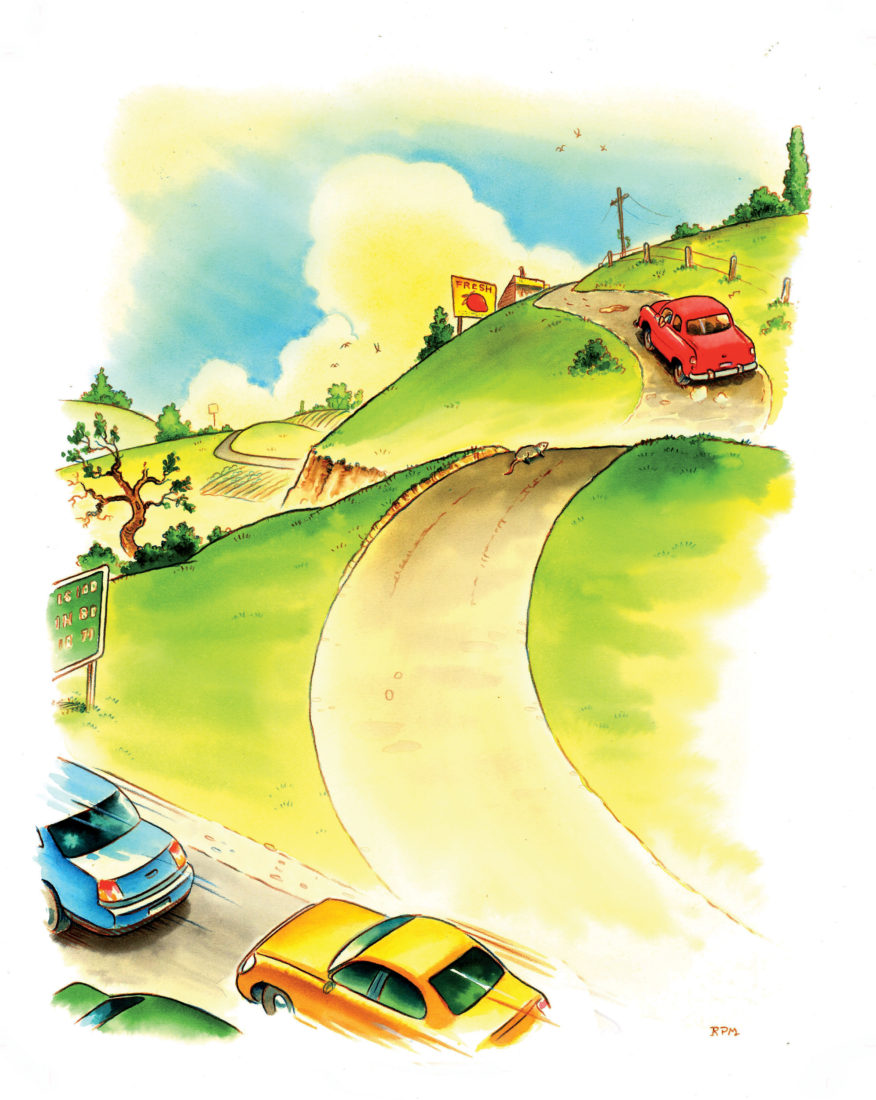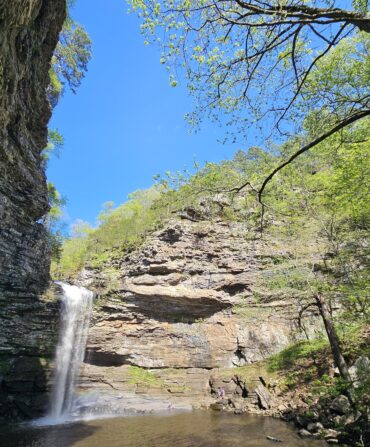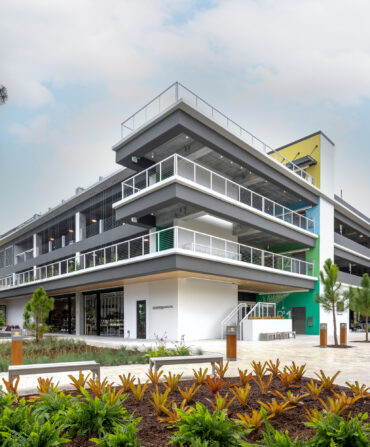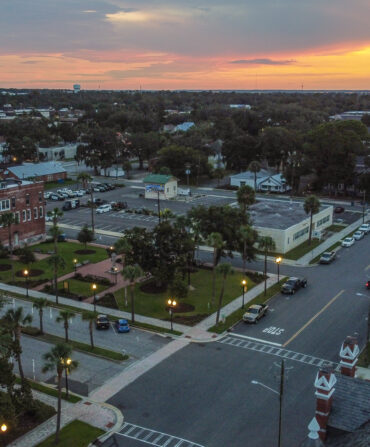They used to be called grand tours. Monocled men in bowler hats (pinkie-extended tea-drinking birders) called it motoring. The first recorded road trips were taken in chariots, in Egypt, over three thousand years ago; the most recent on record was by Mark L. and Sylvia J. of Atlanta. They took I-20 W out of the city and then hit I-65 S in Birmingham (stopping, briefly, to say hello to some of Mark’s cousins) and after about two hundred miles disappeared somewhere near Exit 37, about thirty minutes from their destination, Gulf Shores. Four happy hours later they arrived.
What happened between that exit and Gulf Shores? No one knows but Mark and Sylvia, and it came as a surprise even to them. That’s the heart of the road trip, its epistemological center: not knowing what comes next. The explorers who came before us had to clear away a lot of brush and scare away a lot of bears before they could see where they were going. Our challenge, in this world of scrupulously detailed maps and satellite-guided tours, is to reclaim that same spirit of adventure. Here then, some guidelines to seeing what they saw. Nothing. And everything.
Road trips are not vacations.
Vacations are planned months in advance; they are researched, tested by focus groups, contrasted with vacations past via PowerPoint in an effort to maximize the chances of creating new, vibrant, photographable memories. On a vacation you stay in chain hotels with room service and indoor pools. You make sure you bring a lot of sunblock. You get someone to house-sit and walk the dog and water the garden. On road trips you stay at motels called the Peach Blossom, where there’s no elevator because there’s no second floor, where the 1950s-era illuminated vacancy sign advertises free air-conditioning and ice, where wireless means that the lamps don’t work. You sneak the dog in, but they don’t care, not really. Everyone you meet on a road trip loves dogs.
Get lost.
A road trip wherein one does not get lost is not a road trip, it’s something else, the same way Pringles aren’t really potato chips. If you don’t get lost, you’ll miss all the best yard art, the secret quarries, all the little timeless towns secreted away on the other side of that mysterious hill, sweet towns same as they were fifty years ago, towns where evolution hasn’t happened because most of the people there don’t believe in it. And three-legged dogs—you’ll miss them too.
I once got lost in South Carolina and got the idea for my third book. I passed a sign that read, Welcome to the Strawberry Capital of the World! Sign said it was right around the bend, and I could not wait. What a magical place I was about to enter! A spotless, happy town full of handsome men and beautiful women, with a median age of thirty-two, all giving away bright red luscious strawberries, strawberries as big as cats, dripping juice. The difference between what I imagined and the reality of what I found—an abandoned Main Street, dark empty buildings, tire fires, and lots of three-legged dogs—is what led me to write The Watermelon King. True story.
Get off the highway.
Highways were built by people who want you to get somewhere, not go somewhere. Better to take a road. The best are well-tended paths, paved as if in afterthought, circuitously cutting through ancient forests and someone’s backyard.
There are risks, yes. Once you get off the interstate, your trip is at the whim of every farmer with a thousand-year-old tractor who picks the exact wrong moment to pull in front of your four-wheel funmobile. He’s driving to work, maybe to plow or…whatever it is tractors do. But on a two-lane blacktop as thin as a piece of string you can’t pass him without risking your life, and now you won’t get to Loxahatchee before nightfall. You kind of wanted to watch the sunset in Loxahatchee. But think about this. There is no roadside on a highway, and therefore there are no roadside landmarks. Roadside landmarks peculiar to the South: mermaids, alligators, jewel-encrusted caverns, pecan stands, fruit purveyors in derelict lean-tos, shaded beneath a rusting corrugated metal roof that appears to have been salvaged from some local Armageddon, practically giving away the best apples you’ve ever had in your life. And boiled peanut stands. An admission (and for a Southerner it’s a big, brave one): I’ve never stopped at a boiled peanut stand; I’d sooner stop at a roadside sushi stand. Why boil a peanut? I don’t get it. And let’s call it what it is: a soggy peanut. You call it boiled because no one’s going to stop at a soggy peanut stand.
Play games.
Sad, how the automobile has gone from being a playground to a prison. When I was a kid, I rolled around in the way-back like a basketball, wrestling with my little sister or pleading with the passing truckers to please, please blow their horns, with the traditional downward thrust of the arm, hand fisted, miming as though they might actually be pulling a rope. The blaring horn was the sound of sweet victory. Thank you, Mr. Trucker! How irritating that must have been for him: child after child begging for the same noise. But there is no “way-back” for the kids these days. They’re strapped in like Hannibal Lecter. A family road trip is too often a military exercise in quiet subordination. Does anyone even moon anymore? One can’t help but get nostalgic about the preteen moon.
Still, there are some acceptable games left to play. Everybody knows them: I Spy, Twenty Questions, License Plate, Slug-a-Bug, Name That Tune. Hold Your Breath When You’re in a Tunnel/Passing a Graveyard/When Your Father Passes Gas. But my favorite is simply called Roadkill. There is no game more Southern than this one, and it’s fun, especially if you’re driving through Mississippi. Count the dead possums, armadillos, deer, raccoons, birds, snakes, and frogs, whether they’re smashed flat on the faded white lane-dividing line or unceremoniously shoved to the shoulder. The first to a hundred wins.
Go along for the ride.
There’s an art to everything these days, people say, from the forced poeticism of YouTube videos to shooting skeet and noodling. But road tripping is an art. It’s not unlike writing a novel: The writer (rider?) tells herself she knows where she’s going, but she doesn’t really know. There’s an imaginary destination, a sparkling mirage on the horizon, but all it provides is a general direction. As she writes, the story opens up to her the same way the world does when she turns left instead of right, stops here instead of there. The road she ends up taking is as much a surprise to her as it is to us. Barreling down the two-lane blacktop with the wind in her hair and time on her hands is a mystical splendor unmatched, unmatchable. She may never get where she thinks she’s going, but that’s okay. Soon—tomorrow, the next day, next week or next year—she can just turn around if she wants to. Because while there’s nothing better than leaving home, there’s nothing better than coming back.








